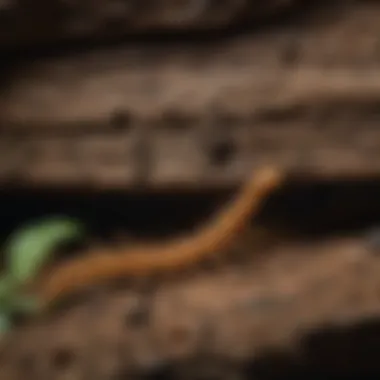Effective Strategies to Keep Centipedes Out of Your Room


Intro
Centipedes, though not the most dangerous of pests, can be a source of discomfort for many homeowners. Understanding how these creatures operate and thrive can be pivotal in keeping them out of your room. This article will unravel effective strategies to deter centipedes from invading your space. We will explore their biology, what attracts them, and credible methods to manage their presence. This knowledge will empower you to create a more serene environment in your home.
Pest Identification
Recognizing a centipede is the first step in managing its presence. Common centipede species like the Scutigera and Lithobius have unique characteristics.
- Scutigera or the house centipede typically measures about 1 to 2 inches long. It has a long, flat body with numerous legs and often sports a brownish-yellow hue but can vary.
- Lithobius, on the other hand, tends to be more robust and can reach lengths of up to 4 inches. Its color ranges from reddish to brown.
Signs of Infestations
Understanding the signs of an infestation is equally crucial. Here are common indicators:
- Sightings: Spotting centipedes in your living space, primarily at night when they are most active.
- Molts: You may find empty exoskeletons; these are remnants from their growth.
Understanding Centipedes
Understanding centipedes is crucial for effectively keeping them out of your home. By gaining insight into their biology and habitat, homeowners can develop targeted strategies to minimize encounters with these pests. The more knowledgeable you are about why centipedes enter your living space, the better equipped you will be to deter them. This section aims to illustrate the significance of comprehending centipedes in the context of pest management.
What are Centipedes?
Centipedes are elongated, multi-legged arthropods belonging to the class Chilopoda. They are characterized by their segmented bodies, with each segment typically housing one pair of legs. Generally, a centipede's body can range from just a few millimeters to over 30 centimeters in length. While they can vary in color, many species exhibit shades of brown or tan. Centipedes are generally nocturnal predators, hunting down small insects and other arthropods.
Biology and Behavior
Centipedes have a fascinating biology that contributes to their survival. They possess a pair of venomous claws, known as maxillipeds, which they use to subdue their prey. This venom can cause irritation or allergic reactions in humans. In terms of behavior, centipedes are often found in dark, damp environments where they can easily ambush their prey. They prefer places with high humidity, such as basements, bathrooms, and under sinks. Understanding their behavior can help in identifying potential breeding and hiding grounds in your home.
Common Species in Homes
Several species of centipedes can commonly be found in homes. The House Centipede, or Scutigera coleoptrata, is one of the most recognized. This species is characterized by long, delicate legs and can move swiftly across surfaces. Another common species is the Stone Centipede, or Lithobius forficatus, which is typically larger and can often be found hiding in moist areas of your home. By knowing which species to look for, homeowners can better prepare themselves for prevention and control measures.
Centipedes' Preferred Habitats
Understanding the habitats centipedes prefer is crucial in the effort to keep them out of your room. Centipedes thrive in environments that provide shelter, moisture, and food sources. By recognizing these factors, homeowners can take strategic measures to deter these pests before they invade living spaces.
Indoor Environments
Within homes, centipedes are commonly found in dark and damp areas. They favor basements, bathrooms, and kitchens due to the availability of moisture and potential food sources, such as insects. These areas often have poor ventilation which makes them ideal for centipedes seeking humid conditions. To reduce the likelihood of centipedes taking up residence indoors, it is essential to keep indoor environments well-organized and dry.
- Seal Cracks and Gaps: Close any openings in walls, around pipes, and windows. This prevents easy access points for centipedes.
- Use Dehumidifiers: In areas like basements and bathrooms, employing dehumidifiers can significantly decrease the moisture level, making these spaces less attractive to centipedes.
- Regularly Clean: Clear out debris and clutter which can serve as hiding spots for centipedes. Cleaner spaces are less inviting to pest presence.
Outdoor Environments
Outdoors, centipedes typically inhabit leaf litter, mulch, and soil. They thrive in moist areas where they can easily find food and shelter. This makes gardens, flower beds, and areas with heavy vegetation prime locations for centipedes.
Their natural predators such as birds and frogs may control their population; however, it is important for homeowners to take steps to limit the convenience centipedes find in outdoor settings:
- Manage Plant Growth: Keep vegetation well-trimmed. Reducing excessive foliage creates less hiding space for centipedes.
- Optimize Mulching Practices: If mulching is necessary in gardens, consider using inorganic materials that do not hold moisture or provide nesting spots.
- Clear Debris: Regularly remove fallen leaves and any organic matter that can retain moisture.
Each element in understanding centipedes’ habitats plays a role in determining successful prevention strategies.
Why Centipedes Enter Rooms
Understanding why centipedes choose to invade living spaces is crucial for effective prevention. These pests are not random intruders; they are driven by specific needs that can often be addressed by homeowners. By identifying the reasons for their presence, you can take targeted measures to discourage them from entering your rooms.
Search for Food
Centipedes are predators that thrive on insects and small arthropods. They prefer moist environments where their prey, such as spiders, cockroaches, and other pests, are likely to inhabit. If your room provides a food source, it becomes a target. Reducing the food supply in and around the house is an effective strategy to deter centipedes. Regular cleaning can help minimize the presence of small insects. Consider the following actions:


- Close gaps in exterior doors and windows.
- Keep food sealed and stored properly.
- Regularly dispose of garbage and organic waste.
By decreasing potential food sources, you diminish the likelihood that centipedes will find your home attractive.
Seeking Moisture
Moisture is another significant factor that attracts centipedes. They thrive in humid conditions and often seek out environments where humidity levels are high. Areas such as basements, bathrooms, and even kitchens can harbor enough moisture to entice these pests. To create an unwelcome environment for centipedes, homeowners can:
- Use dehumidifiers in damp areas.
- Repair any leaks in pipes or fixtures.
- Ensure proper ventilation in areas prone to moisture buildup.
By reducing humidity, you can make your home less inviting and limit the chances of centipedes entering.
Warmth and Shelter
As temperatures drop, centipedes seek warmth and protection from the cold. Your home offers a perfect sanctuary through its heating systems and sheltered nooks. They prefer to hide in dark, moist areas like cracks in walls, under furniture, or within piles of clutter. Here are some recommendations to minimize sheltering potential:
- Keep attics and crawl spaces well-ventilated.
- Store items neatly and off the floor to minimize hiding places.
- Seal cracks and gaps in walls, particularly near foundations.
A proactive approach in organizing and sealing your home reduces the chances of centipedes finding a safe haven.
"Understanding the specific reasons why centipedes enter your home is the first step in effectively preventing them."
By addressing these fundamental factors, homeowners can significantly lower the risk of centipede infestations.
Identifying Signs of Centipede Infestation
Identifying signs of centipede infestation is crucial for homeowners. Awareness is the first step in maintaining a pest-free environment. Centipedes may be elusive, but their presence often leaves clues that can indicate a more significant problem. By being vigilant, one can take appropriate actions before the situation escalates.
Physical Sightings
Physical sightings of centipedes are the most direct indicators of their presence. Centipedes are nocturnal creatures, which makes them more active at night. If you notice small, elongated bodies with numerous legs moving quickly, it is likely a centipede. They can range from a few centimeters to several inches long, depending on the species.
Homeowners should pay attention to the areas where sightings occur. This often includes damp, dark spaces such as:
- Basements
- Bathrooms
- Kitchens
- Under sinks
Regularly checking these locations can help identify infestations early. If a centipede is spotted, take note of its location to help determine potential entry points.
Damage Indicators
In addition to physical sightings, damage indicators can provide further evidence of a centipede problem. While centipedes primarily prey on other pests, such as spiders and insects, they may inadvertently cause signs of their presence through their movement. Look for:
- Small bite marks on furniture or wood
- Webs or droppings left by their prey
- Molted exoskeletons, indicating growth
These signs suggest that centipedes are thriving and may be indicating a larger pest issue in your home. It's essential to assess these indicators carefully. The combination of physical sightings and damage indicators can help in diagnosing the extent of an infestation.
Taking swift action on signs of centipede infestation can prevent them from becoming a larger issue.
Monitoring these signs will aid in identifying the need for preventive measures to keep centipedes at bay.
Preventive Measures
Preventive measures are crucial in minimizing encounters with centipedes in your room. Understanding how to effectively keep these pests at bay can lead to a more comfortable living environment. Implementing key strategies not only disrupts their entry points but also transforms your space into a less appealing habitat for them. Homeowners should prioritize these methods to ensure their living areas remain centipede-free.
Sealing Entry Points
Cracks and Gaps
Cracks and gaps in walls, floors, and baseboards provide easy access for centipedes. These openings often go unnoticed, which makes them a significant problem. A notable characteristic of cracks is their ability to widen over time, thus increasing the likelihood of pest invasions. Closing these gaps not only blocks centipedes but also other unwanted insects, contributing to an overall healthier environment.
The unique feature of sealing cracks is that it can be accomplished with basic materials. Caulk or sealant can effectively fill these openings. The main advantage of this strategy is its low cost and ease of application. However, homeowners must be vigilant in regularly checking these seals for any signs of wear or damage.


Windows and Doors
Windows and doors are primary access points for centipedes. If they are not properly sealed, they can serve as gateways for these pests. A key characteristic of windows and doors is their exposure to outside elements, making them vulnerable spots for invasion. Installing weather stripping or door sweeps can be an effective way to enhance protection against centipedes.
Using these methods creates a physical barrier that is both noticeable and effective. One advantage of focusing on windows and doors is that it addresses two sources of potential entries simultaneously. However, if not installed correctly, the barriers may not work effectively, so attention to detail is essential.
Reducing Indoor Moisture
Reducing indoor moisture is an effective strategy because centipedes thrive in dampness. Areas such as bathrooms, kitchens, and basements can often have elevated humidity, creating an inviting environment for these pests. Homeowners can combat this by using dehumidifiers and ensuring proper ventilation throughout the house. This method not only decreases the likelihood of centipedes but also contributes to improved air quality overall.
Clearing Clutter
Clutter provides shelter for centipedes, enabling them to hide and breed. Regularly organizing and decluttering different spaces in your home can significantly deter their presence. Keeping floors and surfaces clear of unnecessary items minimizes hiding spots, making your room less attractive to these pests. Being organized has the added benefit of creating a more pleasant living environment.
Utilizing Insecticides Safely
Choosing the Right Products
When considering chemical options, choosing the right insecticides is vital. Selecting products specifically designed for centipedes can enhance their efficacy. A key characteristic of these products is their targeted application, which reduces the risk of exposure to humans and pets. A significant advantage of using chemical solutions is the immediate impact they can have on centipede populations. However, caution should be exercised to prevent any adverse effects from improper application.
Application Strategies
Effective application strategies for insecticides are necessary for maximizing their benefits. Following manufacturer instructions closely will ensure the safest and most effective use. Spraying areas where centipedes are likely to hide, such as corners and beneath furniture, can create a protective barrier. Regularly re-treating these areas is also beneficial in sustaining effectiveness. While using insecticides provides quick solutions, reliance on them alone may disregard long-term preventive measures.
Natural Deterrents
Natural deterrents play a crucial role in keeping centipedes out of your room. Unlike chemical pesticides, these alternatives are often safer for both people and pets. They provide a means to create unfavorable conditions that discourage centipedes from invading your space. By understanding and utilizing natural deterrents effectively, homeowners can maintain a pest-free environment without the risks associated with harsh chemicals.
Essential Oils
Essential oils are one of the most popular natural deterrents against centipedes. Certain oils, such as peppermint, tea tree, and lavender, have properties that are repellent to these pests. Their strong scents interfere with the centipedes' sensory perceptions, making the environment less inviting.
To use essential oils effectively, homeowners can mix a combination of 10-15 drops of essential oil with water in a spray bottle. This mixture can then be sprayed around entry points, baseboards, and areas where centipedes are commonly seen. However, it is essential to apply this mixture regularly, as the scent dissipates over time.
"Using essential oils as a repellent not only helps in pest management but also adds a pleasant aroma to your living space."
It's also a good idea to experiment with different oils to find which one is the most effective in your specific environment. Remember, certain oils can cause allergic reactions for some individuals, so a patch test may be wise beforehand.
Diatomaceous Earth
Diatomaceous earth is another effective natural deterrent against centipedes. This substance consists of tiny, fossilized algae known as diatoms, which have abrasive properties. When centipedes come into contact with diatomaceous earth, it damages their exoskeleton, leading to dehydration and eventual death.
To use diatomaceous earth, homeowners should sprinkle it in areas where centipedes are likely to enter or hide, such as around windows, door frames, and along the perimeter of the home. It is crucial to ensure the layer remains dry in order for it to be effective.
While diatomaceous earth is safe for humans and pets, caution is advised. Avoid inhaling the dust as it can be harmful to respiratory health. Applying the earth in small amounts in necessary areas is best.
Combining essential oils and diatomaceous earth can enhance the overall effectiveness of your pest control strategy. By utilizing these natural deterrents, homeowners can create a serene environment that is hostile to centipedes.
Creating Unfavorable Conditions
Creating unfavorable conditions for centipedes is critical when seeking to keep them out of your room. Understanding their needs will help develop an effective environment that discourages their presence. Centipedes thrive in damp, dark, and cluttered areas. By addressing these elements, one can significantly reduce the likelihood of an infestation.
Controlling Indoor Temperature
Temperature plays an important role in many pests’ behaviors, centipedes included. They prefer warm environments because it aids their metabolism and breeding. Keeping indoor temperatures less favorable can help deter them. Aim for cooler temperatures in your home, especially during the warmer months. This doesn’t mean making your space uncomfortable but rather adjusting your thermostat slightly to reduce the warmth in areas where you suspect centipedes may thrive.
A well-regulated temperature not only aids in pest prevention but also benefits your energy bills. Make sure to check areas that are prone to heat retention, like attics or poorly ventilated rooms. Often, adjusting air vents or using fans can help create a less hospitable environment for centipedes and similar pests.
Implementing Regular Cleaning Routines
Regular cleaning is essential for maintaining a centipede-free space. A clean environment is less appealing for these creatures as it diminishes their hiding spots and food sources. Consider dusting and vacuuming your room frequently, especially in corners, under furniture, and behind appliances where centipedes often hide.


Since centipedes feed on small pests and organic matter, thoroughly cleaning surfaces is crucial. Pay attention to the following:
- Declutter areas: Remove unnecessary items from floors, under beds, and in closets to eliminate hiding spaces.
- Wash bedding regularly: This helps to keep your living space fresh.
- Use a vacuum: Regularly vacuuming can help suck up any centipedes and their food sources.
By integrating these cleaning habits into your routine, you create an environment that is not only unfavorable for centipedes but also promotes overall cleanliness in your home.
Professional Pest Control Options
Addressing the issue of centipedes in your living space often requires a multifaceted approach. While many homeowners initially opt for DIY strategies, there are instances when enlisting professional pest control services becomes crucial. Understanding the specific benefits and considerations of professional pest control can equip you with the knowledge needed to make a well-informed decision.
When to Consider Professional Help
Determining the right time to call for professional pest control can depend on various factors. If you frequently encounter centipedes, it may signal a more significant underlying problem that requires expert intervention.
Some conditions to consider include:
- High Infestation Levels: If you notice a rise in centipede sightings or find them in areas you do not frequently visit, it may be time to contact a professional.
- Health Concerns: Centipedes can cause allergic reactions in sensitive individuals. If you or any family member experiences health issues related to pests, it is advisable to get help.
- Inadequate DIY Solutions: Sometimes, home remedies or over-the-counter products do not yield desired results. If that is the case, seek professional advice.p>
Choosing a Pest Control Service
Selecting the right pest control service is essential for effective treatment against centipedes. Here are some strategic steps to follow:
- Research Local Services: Look for pest control companies that specialize in centipede management. Customer reviews and testimonials can provide insights into their effectiveness.
- Verify Credentials: Ensure that the pest control service is licensed and insured. This guarantees that they adhere to industry standards and regulations.
- Discuss Methods: Have a conversation with the service provider about their approach. Inquire whether they use chemical treatments, eco-friendly options, or both.
- Request Quotes: Gather quotes from multiple companies. Compare their services and prices to make an informed choice.
A well-chosen pest control service can significantly reduce centipede presence, ensuring a healthier living environment and peace of mind.
- Evaluate Follow-Up Services: Ask about their follow-up procedures. Continuous monitoring or additional treatments can help maintain a pest-free space.
Monitoring and Maintenance
Monitoring and maintenance play a crucial role in preventing centipedes from becoming unwelcome house guests. Taking proactive steps to keep these pests at bay ensures not only the comfort of living spaces but also the overall health of your household. Effective monitoring involves consistently keeping an eye on potential entry points, food sources, and environmental conditions that are conducive to centipede presence.
Regular maintenance, on the other hand, emphasizes the need to regularly verify the effectiveness of preventive measures put in place. This ongoing vigilance can catch infestations in their early stages, making eradication much easier. Moreover, a structured approach to monitoring and maintenance fosters a cleaner, healthier environment—which is beneficial for all residents in the home.
Establishing a Monitoring Plan
The establishment of a monitoring plan is vital in your battle against centipedes. This plan should outline specific tasks and timeframes for checking areas that might attract these pests. Identify the spots in your home that tend to be damp, dark, and cluttered, as these are the environments favored by centipedes.
In your monitoring plan, incorporate the following elements:
- Define specific areas to monitor, such as basements, bathrooms, and crawlspaces.
- Set a schedule for inspections, ideally monthly.
- Document findings during inspections to identify patterns or trends in centipede activity.
A clear and structured monitoring plan not only enhances pest control efforts but also encourages a routine that can lead to improved overall home maintenance.
Regular Inspections
Conducting regular inspections is vital for catching centipedes before they become a significant issue. During these inspections, pay close attention to the previously identified areas, particularly checking for any unexpected moisture or signs of pest activity.
Here are some specific elements to focus on during your inspections:
- Visual Checks: Look for physical sightings of centipedes in dark corners, baseboards, and behind furniture.
- Moisture Levels: Check for leaks or moisture buildup that may provide a suitable habitat for centipedes.
- Debris and Clutter: Ensure that storage areas are not overly cluttered, as clutter provides both shelter and food sources.
Regular inspections can help in noticing unusual changes in the environment that may invite centipedes. This preventive approach not only aids in the timely removal of any invasive species but also fosters a cleaner and safer living space.
Closure
The key elements we discussed emphasize the significance of comprehensive preventive measures. For instance, sealing entry points can effectively stop centipedes from accessing your home. Reducing indoor moisture and clearing clutter are essential practices that create unfavorable conditions for these creatures. Furthermore, utilizing natural deterrents, like essential oils or diatomaceous earth, adds to your defense against centipedes.
Regular monitoring and maintenance of your home will help ensure that these preventive tactics remain effective. If needed, don’t hesitate to seek professional pest control services. Understanding when and how to engage such services can make a significant difference in maintaining a pest-free environment.
Ultimately, the benefits of implementing these strategies go beyond just keeping centipedes away. A clean, well-maintained, and proactively managed living space contributes to a healthier lifestyle and a more comfortable atmosphere.
Summary of Key Strategies
- Sealing Entry Points: Close off cracks and gaps, especially around windows and doors.
- Reducing Indoor Moisture: Use dehumidifiers and ensure proper ventilation to lower humidity levels.
- Clearing Clutter: Keep areas tidy and free from unnecessary items that might provide hiding spots.
- Natural and Chemical Deterrents: Explore options like essential oils and diatomaceous earth, and consider insecticides, if necessary.
- Regular Monitoring: Establish a routine to check for signs of centipede presence and address any issues promptly.
By advocating these methods and remaining diligent, you can safeguard your home against unwanted intrusions and foster an environment that promotes both comfort and health.



